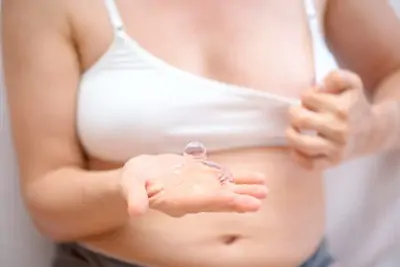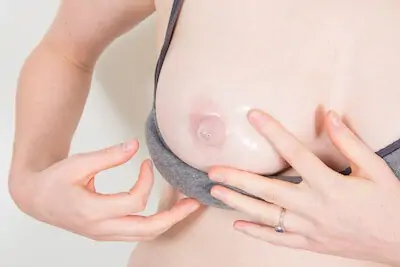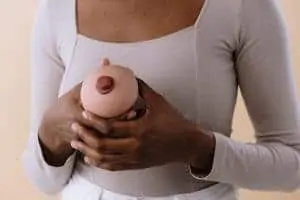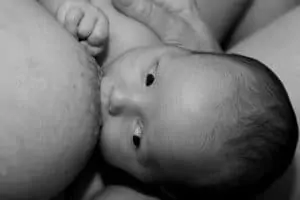An old, dear friend of mine from school just had a baby with his long-time girlfriend. He already has an adult daughter, and this was a wonderful surprise for his family.
But his girlfriend is a first-time mom who was having trouble getting a good latch. I recommended he see if they could find a lactation consultant at the hospital or through La Leche League. I also suggested they think about trying a nipple shield to kick things off.
It’s funny how stuff like this works because no sooner than I’d had this conversation with him, I started getting tons of questions about nipple shields. So, I thought I’d better compile them all into one handy post so you’ll have all your questions about it answered.

For those of you that don’t know, a nipple shield is made from thin, flexible silicone and looks much like those nipples you see on a baby bottle. It’s designed to fit over your nipple and areola. This gives you a protective cover while making it easier for your baby to latch.
At the tip of the nipple of the shield, it has a small hole that lets the milk flow for your baby.
Not everyone needs them. In fact, I recommend you don’t just get one unless a lactation consultant or breastfeeding coach has suggested you use it. Some instances where these things will come in handy:
- You have inverted or flat nipples
- You have a preemie that hasn’t fully developed the sucking reflex
- Baby has weak sucking or issues with sucking
- Baby needs extra stimulation for sucking
Keep reading, and I’ll cover the nipple shield pros and cons so you can see if you may want to talk to your lactation consultant about it.
Pros and Cons of Using a Nipple Shield
Keep reading, and I’ll cover the nipple shield pros and cons so you can see if you may want to talk to your lactation consultant about it.
Benefits
What do you get out of using a nipple shield as a new mom? It can help you by saving you from sore nipples and discomfort as you first start breastfeeding. This is often why many women give up on breastfeeding in those crucial first days and weeks.

Yes, you can use plenty of things to relieve your nipples, but a nipple shield adds comfort and relief, making it easy for you to get started with breastfeeding.
A nipple shield will also benefit your newborn because it can help her latch quickly. Additionally, a nipple shield for overactive letdown can help you control the flow just a bit more, so you’re not overwhelming your newborn, especially a preemie, with a heavy flow.
Disadvantages
While nipple shields are very helpful in getting started with breastfeeding, there are a few things to keep in mind. For starters, permanently using a nipple shield is never recommended.
Then there’s the fact that these things add more maintenance for you. You need to clean it well to avoid bacteria growth which can make your baby sick.
And while a nipple shield for overactive letdown is an excellent temporary solution, keep in mind that that shield can slow down the flow of your milk. This affects your milk supply and how much milk your baby is getting.
However, you can work around that by pumping right after breastfeeding to keep your supply strong. To ensure your baby is getting enough milk and growing well, make sure you weigh her each week.
And the other disadvantage you’ll have is weaning from a nipple shield. This is why working with a lactation consultant can help you use this handy tool well without hitting any pitfalls.
Weaning your baby from the nipple shield
If your lactation consultant recommends it, don’t be afraid to use a nipple shield for breastfeeding your baby. You just have to prep yourself for the weaning process. Remember, permanently using a nipple shield is not recommended. It’s to help bridge that gap so you can breastfeed successfully once you get a good latch.
To wean, you can start with the nipple shield during feeding and take it off halfway through the nursing session. You can also do so when you switch breasts.
Another way? Get a deep latch! See my post about how to do that, and you won’t need it anymore!
You can also try more tricks to help your baby breastfeed without the crutch of a nipple shield:
- Pump first to get the milk flowing. This will also firm up and elongate your nipple for easier latching for your baby.
- Give your nipple a gentle massage (with clean fingers!) before you latch on. Some say to use ice, which is a good idea only if you do so very briefly. Otherwise, you can numb the area and not feel if the latch is right.
- Skin-to-skin nursing is a great way too. I’ve written a post about that, so check it out!
- Ask your lactation consultant about different nursing positions that can help. Sometimes, all it takes is finding the right position for that perfect latch to happen.
- Learn the early hunger cues. When baby is crying, it’s already too late, making it harder to get that latch.
And now, I’d like to cover all the questions I’ve received about using nipple shields. I hope you will work with a lactation consultant or breastfeeding coach along with your pediatrician to help make nursing your baby as easy as possible.
Why would you use a nipple shield?
Nipple shields are a great tool when you have trouble getting a newborn to breastfeed. These are especially helpful for preemies since they help you create suction and position your nipple correctly.
A nipple shield also lets your baby breathe and pause as needed without the need to reposition. It’s a great tool though you should not be using it all that long.
Are nipple shields good for breastfeeding?
Yes, nipple shields are suitable for breastfeeding, though they’re a temporary solution. If you have a preemie, you will likely use it a little longer than other moms. The goal of using a nipple shield is to get the baby nursing properly. Once that happens, you can bid adieu to the shield and breastfeed without it.
How to use a nipple shield for nursing?

Your lactation consultant will likely show you how, but if you’re trying to figure it out on your own, here’s how to use them:
- Use lukewarm water to moisten just the edges of the nipple shield. This will keep it from moving.
- Turn it inside out.
- Gently smooth it onto one of your breasts. Your nipple tip should fit into the nipple of the shield. The feel should be tight against your breast, with the nipple extended into the tip.
- Now, either express some of your milk into the tip or drip expressed milk on the outer part of the nipple to get baby to latch on.
- During nursing, you can express milk by hand into your baby’s mouth to keep her nursing if you notice the flow slowing.
- Don’t forget to wash it well after every use!
Is it bad if you always use a nipple shield?
Yes, it can be a bad thing to use a nipple shield regularly. These are only designed for use for a short time. In other words, you’re not going to need it for the entire first year of nursing your baby, just a few weeks or so.
With a nipple shield, incorrect use can cause your baby not to get enough milk. You can also have a greater risk for clogged ducts and mastitis. And then there’s the weaning process…when you depend on this thing too much, it will be harder for both you and baby to stop using it.
Do nipple shields cause clogged ducts?
While it’s not a guarantee you’ll wind up with clogged ducts when using a nipple shield, you certainly have a greater chance of it. It can prevent your baby from properly emptying your breasts.
To avoid that, though, you should pump after nursing to ensure all your milk has been drained. This additionally helps you keep up your milk supply when your baby isn’t suckling as well.
How to clean the nipple shield?
Your breastmilk can dry on the nipple shield and breed bacteria. This bacteria can make your baby very sick, so you must clean it every time. Wash it with hot, soapy water. Then be sure to rinse it completely away with hot water, running it over and over the nipple shield to remove any lingering remnants of bacteria and soap.
Dry it well, then store it properly in a clean container with a cover.
How to get a nipple shield to stay on?
Are you having trouble getting your nipple shield to stay in place? Try these tips:
- Put it in warm water before you apply it.
- Flip it inside out. You’ll want the flat part rolled a little over the part that looks like a hat. Then you can put it on by rolling it over your nipple.
- Try lanolin or medical tape.
- Hold it there (less desirable, but it works in a pinch).
- Change the size to one that is either smaller or larger.
Here’s how to put on a nipple shield step by step.
Does a nipple shield help with pain?
Yes, it does when you use it properly. If you have cuts, cracks, or fissures on your nipple, a nipple shield is a savior that will help you breastfeed without nipple pain. But do keep in mind that you can wind up with more pain if your milk isn’t fully drained. Pumping afterward will help with that.
Is a nipple shield recommended?
Nipple shields are not recommended for every new mama. Working with a lactation consultant is the best way to know if it’s right. She’ll help you find one that fits your breasts properly and show you how to use it too.
If you have any of the problems described above, it might be helpful to use a nipple shield. I absolutely recommend talking to your doctor about any concerns here to get support from those around you for successful breastfeeding.
Does feeding with a nipple shield take longer?
Yes, it may take longer for feeding when you wear a nipple shield. That’s because it can take milk longer to flow from your breast when you’re using it.
And again, make sure you express your milk for a couple of minutes per breast after your feedings with a nipple shield to prevent blockage.
How do I choose one?
Nipple shields are not one-size-fits-all. The sizes reflect the diameter of the nipples on these shields. Your lactation consultant or doctor can help you figure out which one is the right size for you, so you’ll get a comfortable fit that helps your baby get the milk she needs.
How long can I use my nipple shield?
You should only use the nipple shield until your baby can latch on and breastfeed properly on her own. It could take a few days or even a few weeks. Once that happens, stop using the it.
A final word about nipple shields…
Nipple shields are a great temporary solution that can help you with early breastfeeding problems. However, it would help if you spoke with your doctor and lactation consultant before using one.
It may not be necessary if you can get a deep latch. Also, since sizes vary, getting the right one is important. Don’t just go into it blindly, and you’ll see if this handy tool is right for you as you embark on your breastfeeding adventures!
Leslie Berry lives with her husband and two young daughters in Los Altos, California, where she loves helping other moms get comfortable with motherhood and embracing the insanity with facts peppered with laughs.
She loves eating too much sushi, exercising, and jamming out on her Fender. Read more about Leslie here.








